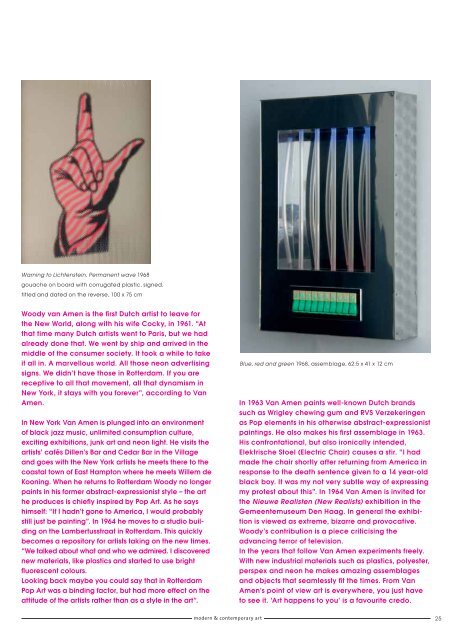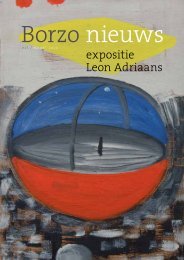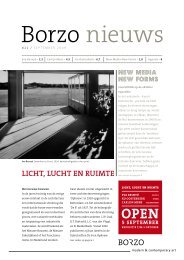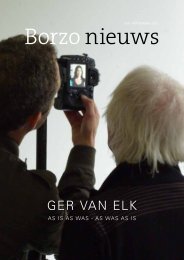nieuw realisme en pop art uit de jaren 60 - Borzo
nieuw realisme en pop art uit de jaren 60 - Borzo
nieuw realisme en pop art uit de jaren 60 - Borzo
Create successful ePaper yourself
Turn your PDF publications into a flip-book with our unique Google optimized e-Paper software.
Warning to Licht<strong>en</strong>stein, Perman<strong>en</strong>t wave 1968<br />
gouache on board with corrugated plastic, signed,<br />
titled and dated on the reverse, 100 x 75 cm<br />
Woody van Am<strong>en</strong> is the fi rst Dutch <strong>art</strong>ist to leave for<br />
the New World, along with his wife Cocky, in 1961. “At<br />
that time many Dutch <strong>art</strong>ists w<strong>en</strong>t to Paris, but we had<br />
already done that. We w<strong>en</strong>t by ship and arrived in the<br />
middle of the consumer society. It took a while to take<br />
it all in. A marvellous world. All those neon advertising<br />
signs. We didn’t have those in Rotterdam. If you are<br />
receptive to all that movem<strong>en</strong>t, all that dynamism in<br />
New York, it stays with you forever”, according to Van<br />
Am<strong>en</strong>.<br />
In New York Van Am<strong>en</strong> is plunged into an <strong>en</strong>vironm<strong>en</strong>t<br />
of black jazz music, unlimited consumption culture,<br />
exciting exhibitions, junk <strong>art</strong> and neon light. He visits the<br />
<strong>art</strong>ists’ cafés Dill<strong>en</strong>’s Bar and Cedar Bar in the Village<br />
and goes with the New York <strong>art</strong>ists he meets there to the<br />
coastal town of East Hampton where he meets Willem <strong>de</strong><br />
Kooning. Wh<strong>en</strong> he returns to Rotterdam Woody no longer<br />
paints in his former abstract-expressionist style – the <strong>art</strong><br />
he produces is chiefl y inspired by Pop Art. As he says<br />
himself: “If I hadn’t gone to America, I would probably<br />
still just be painting”. In 1964 he moves to a studio building<br />
on the Lambertusstraat in Rotterdam. This quickly<br />
becomes a repository for <strong>art</strong>ists taking on the new times.<br />
“We talked about what and who we admired. I discovered<br />
new materials, like plastics and st<strong>art</strong>ed to use bright<br />
fl uoresc<strong>en</strong>t colours.<br />
Looking back maybe you could say that in Rotterdam<br />
Pop Art was a binding factor, but had more effect on the<br />
attitu<strong>de</strong> of the <strong>art</strong>ists rather than as a style in the <strong>art</strong>”.<br />
mo<strong>de</strong>rn & contemporary <strong>art</strong><br />
Blue, red and gre<strong>en</strong> 1968, assemblage, 62.5 x 41 x 12 cm<br />
In 1963 Van Am<strong>en</strong> paints well-known Dutch brands<br />
such as Wrigley chewing gum and RVS Verzekering<strong>en</strong><br />
as Pop elem<strong>en</strong>ts in his otherwise abstract-expressionist<br />
paintings. He also makes his fi rst assemblage in 1963.<br />
His confrontational, but also ironically int<strong>en</strong><strong>de</strong>d,<br />
Elektrische Stoel (Electric Chair) causes a stir. “I had<br />
ma<strong>de</strong> the chair shortly after returning from America in<br />
response to the <strong>de</strong>ath s<strong>en</strong>t<strong>en</strong>ce giv<strong>en</strong> to a 14 year-old<br />
black boy. It was my not very subtle way of expressing<br />
my protest about this”. In 1964 Van Am<strong>en</strong> is invited for<br />
the Nieuwe Realist<strong>en</strong> (New Realists) exhibition in the<br />
Geme<strong>en</strong>temuseum D<strong>en</strong> Haag. In g<strong>en</strong>eral the exhibition<br />
is viewed as extreme, bizarre and provocative.<br />
Woody’s contribution is a piece criticising the<br />
advancing terror of television.<br />
In the years that follow Van Am<strong>en</strong> experim<strong>en</strong>ts freely.<br />
With new industrial materials such as plastics, polyester,<br />
perspex and neon he makes amazing assemblages<br />
and objects that seamlessly fi t the times. From Van<br />
Am<strong>en</strong>’s point of view <strong>art</strong> is everywhere, you just have<br />
to see it. ‘Art happ<strong>en</strong>s to you’ is a favourite credo.<br />
25





